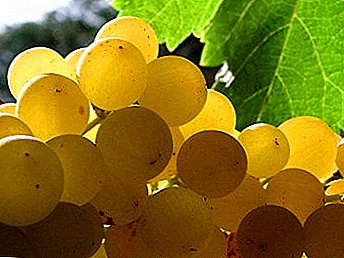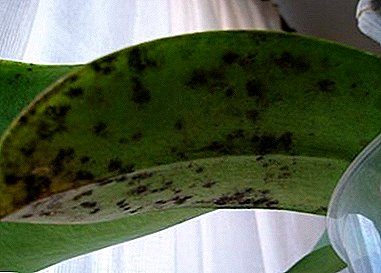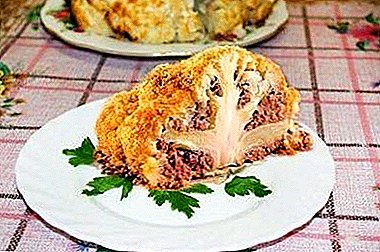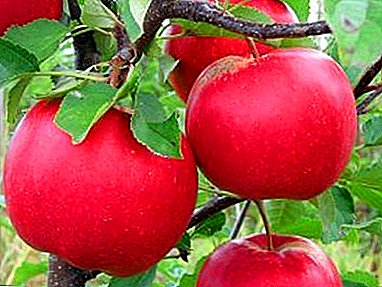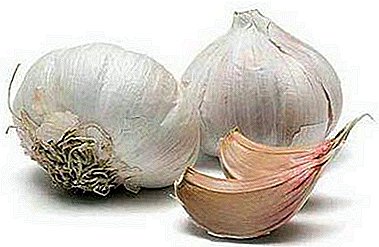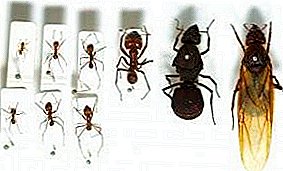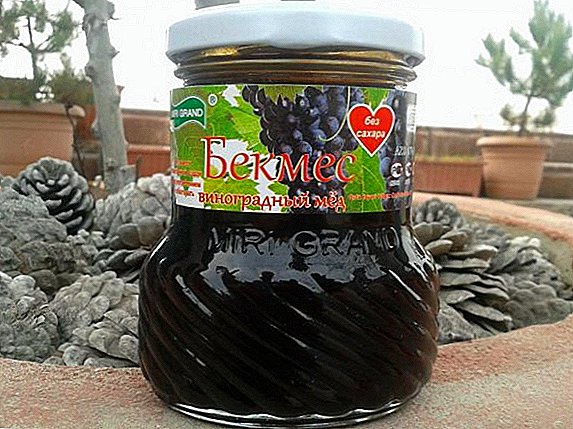
All farmers and gardeners have different tastes, someone loves sweet varieties, while others are delighted with lettuce juicy giants. Anyone who wants to get a high yield and has a lot of space in the greenhouse should pay attention to a very decent sweet variety.
And it is called "Raspberry Honey". This tomato has proven to be very tasty, fruitful, but not too resistant to diseases. A full description of the variety, its characteristics and cultivation features can be found in our article.
Raspberry Honey Tomato: variety description
| Grade name | Raspberry honey |
| general description | Early ripe indeterminate variety |
| Originator | Russia |
| Ripening | 90-95 days |
| The form | Round |
| Colour | Pink |
| Average tomato mass | 500-800 grams |
| Application | Dining room |
| Yield varieties | up to 25 kg per square meter |
| Features of growing | Agrotechnika standard |
| Disease resistance | Not the highest immunity |
 "Raspberry honey" has a good reputation among lovers of sweet meaty tomatoes.
"Raspberry honey" has a good reputation among lovers of sweet meaty tomatoes.
This is an early variety, from the time the seedlings are planted to the collection of the first fruits, 90-95 days pass. The plant is standard, indeterminate, poorly leafy, branches rather weak for large fruits. Read about determinant varieties here.
The bush itself is very high and can reach 150 cm. This variety is recommended for cultivation in unprotected soil and in greenhouse shelters. Immunity is weak, so you need good protection from disease.
 Read more on our website: All about solanaceous diseases: verticilli, Alternaria, fusarium and blight.
Read more on our website: All about solanaceous diseases: verticilli, Alternaria, fusarium and blight.And also, varieties with high immunity, not ill with late blight and the most effective measures of protection against late blight.
Specifications
Ripened fruits have a red or hot pink color, round in shape, lettuce, without a green spot at the base. The pulp is dense, fleshy. The first tomatoes can reach 800 grams, but later from 500 to 600 grams. The number of chambers 5-6, the solids content of about 5%.
You can compare this indicator with tomatoes of other varieties using the data below:
| Grade name | Fruit weight |
| Raspberry honey | 500-800 grams |
| Bobcat | 180-240 grams |
| Podsinskoe miracle | 150-300 grams |
| Yusupovskiy | 500-600 grams |
| Polbyg | 100-130 grams |
| The president | 250-300 grams |
| Pink Lady | 230-280 grams |
| Bella Rosa | 180-220 grams |
| Countryman | 60-80 grams |
| Red Guard | 230 grams |
| Raspberry jingle | 150 grams |
Collected fruits are not stored for long and it does not matter that they carry the transportation over long distances. Farmers do not like it very much for these properties and rarely grow tomatoes Raspberry honey in large volumes.
This type of tomato was bred by domestic experts, in 2008 received state registration as a variety intended for cultivation in greenhouse shelters and in unprotected soil. Since then, it deserves respect among lovers of salad species.
The plant is thermophilic and loves light very much; therefore, it is better to grow it in the southern regions if you plan to do this in open ground. Under the film gives good results in areas of the middle band. In more northern regions it is grown only in greenhouses..
Fruits of tomato "Raspberry honey" will be good in summer salads and in first courses.
Tomatoes of the first collection are not suitable for conservation, as they are too large for this, it is better to wait for the second or third collection. They will be smaller and then it will be possible to preserve. Juices and pastes are very tasty.
This type of tomato is appreciated, including for high yield. With careful care from each bush you can get up to 8-9 kg. Recommended planting density 2-3 bush per square. m, and comes out about 25 kg. This is a very good indicator of yield.
| Grade name | Yield |
| Raspberry honey | up to 25 kg per square meter |
| Bony m | 14-16 kg per square meter |
| Aurora F1 | 13-16 kg per square meter |
| Leopold | 3-4 kg from a bush |
| Sanka | 15 kg per square meter |
| Argonaut F1 | 4.5 kg from a bush |
| Kibits | 3.5 kg from a bush |
| Heavyweight Siberia | 11-12 kg per square meter |
| Honey Cream | 4 kg per square meter |
| Ob domes | 4-6 kg from a bush |
| Marina Grove | 15-17 kg per square meter |
Advantages and disadvantages
Among the main positive qualities of the variety "Raspberry honey" note:
- high yield;
- large tasty fruits;
- universality of use;
- high varietal properties.
Among deficiencies It is noted that this variety is very capricious to the mode of irrigation and lighting.
Also a disadvantage is that the plant weak immunity to disease, weak branches and hands, it needs an obligatory garter of fruits and branches.
A photo
Look at the photo: tomatoes Raspberry honey



Features of growing
Among the peculiarities of the type of tomato "Raspberry Honey", many note its high yield and friendly fruit ripening. But the plant has a weak immunity, as well as very thin brushes and branches..
Shrubs plants form in one or two stems, often in two. The plant is very high and needs a garter, it will serve as additional protection from the wind if it grows in open ground. "Raspberry honey" loves the sun and warmth. At the developmental stage, she loves top dressing containing potassium and phosphorus. Fertilization 4-5 times per season. Watering moderate, in the evening with warm water.
As for fertilizers, you can read more about this topic in separate articles of our site. Read all about:
- Complex, mineral, phosphoric, organic and ready-made fertilizers.
- How to feed tomatoes with ash, yeast, ammonia, boric acid, iodine, hydrogen peroxide.
- Fertilizers when picking, for seedlings, foliar and top best.
Diseases and pests
The most likely disease of this variety is the apical rot of tomatoes. They fight against it, reducing the nitrogen content in the soil, while adding calcium. Also effective measures will be an increase in soil moisture and spraying affected plants with calcium nitrate solution. The second most common disease is brown spotting. For its prevention and treatment it is necessary to reduce watering and adjust the temperature, regularly airing the greenhouse.
IMPORTANT: Of malicious insects often damaged by melon gum and thrips, the Bison is successfully used against them. In the open ground is attacked by slugs, they are harvested by hand, all the tops and weeds are removed, and the ground is sprinkled with coarse sand and lime, creating unique barriers.
Conclusion
As you can see, in the care of the variety "Raspberry honey" there are certain difficulties, it is not suitable for beginners and farmers without experience. But over time, you all must succeed. Good luck on your summer cottage.
| Medium early | Superearly | Mid-season |
| Ivanovich | Moscow stars | Pink Elephant |
| Timofey | Debut | Crimson onslaught |
| Black truffle | Leopold | Orange |
| Rosaliz | President 2 | Bull forehead |
| Sugar giant | The miracle of cinnamon | Strawberry dessert |
| Orange giant | Pink Impreshn | Snow tale |
| One hundred pounds | Alpha | Yellow ball |


